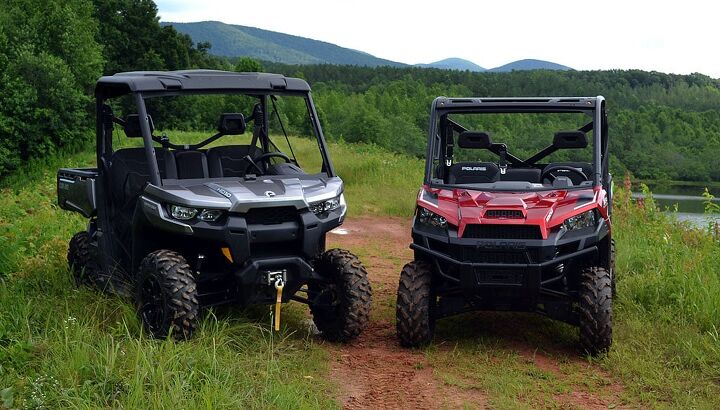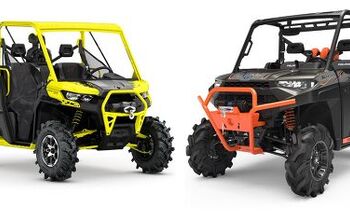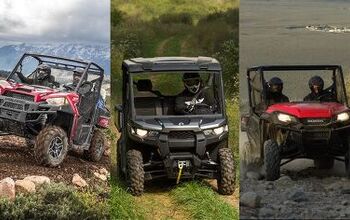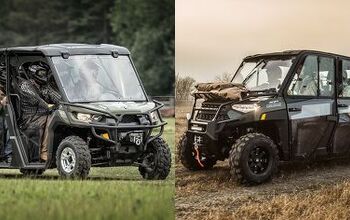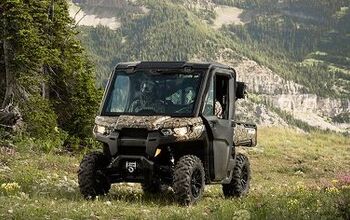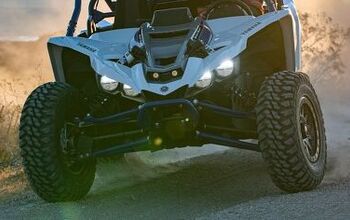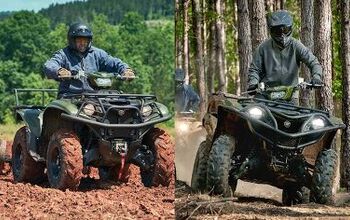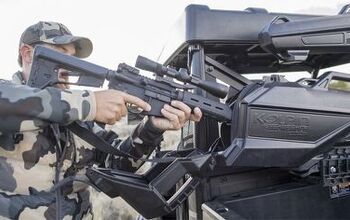2017 Can-Am Defender HD10 XT vs. Polaris Ranger XP 1000 EPS + Video
If you are in the market for a powerful UTV that will not only work hard but that can be trail ridden with kid gloves, than you have come to the right place. Our big brute test between the 2017 Can-Am Defender HD10 XT and Polaris Ranger XP 1000 EPS was quite possibly the high-power highlight of our adventures in the mountains of northern Georgia. These two machines are not only capable of towing many pounds of work gear and material, but they both have the grunt from some of the best engine designs in our industry.
Innovation is a word that gets thrown around in the engineering office at both Can-Am and Polaris. In 2017 with the stakes getting higher for market share and wow factors becoming increasingly demanded by you the consumer, we can tell you this: both companies are listening well. This matchup gave us an opportunity to really digest just how similar and yet vastly different these two Side-by-Sides are.
Engine
Finding a powerful engine in the UTV market today is not a difficult task by any means and with the Polaris ProStar Inline Twin we would say you already know it’s a winner in the world of high speed power and desert performance. However, it is slightly detuned for the Polaris Ranger line and it gives the Polaris Ranger XP 1000 EPS loads of usable torque as well as responsive thrust to get this machine moving quickly. The low-end growl of this 996cc mill gave us the ability to tow our trailer (weighing approximately 1500 lbs – trailer and cargo) in many different conditions and with the selectable throttle mode switch in the work mode the throttle delivery was smooth and predictable. The “after hours” play on the trail was also enjoyable with power that seemed to outrun the chassis’ ability to tame it in performance mode. Being the quieter of the two engines, this ProStar powerplant is positioned under the bed to remove unwanted noise from the cab.
Polaris ProStar Engine
And then in steps the 2017 Can-Am Defender HD10 XT’s Rotax V-Twin. This has also been a favorite among the champions of off-road and slipped down into the frame of the Defender it does not disappoint. The powerful torque of this mill, along with its rich history of reliability under pressure, make it a force to be reckoned with. This 976cc fuel injected Twin also gave us no issue when towing and seemed oblivious to the load behind it. Strong, smooth power delivery and a spirited ramp into a seemingly bottomless array of power makes this a great tool for any working situation.
Rotax HD10 Engine
Once our towing had been completed, our trail time was also enjoyable as the Can-Am Defender HD10 XT is ready for adventure and like the Polaris Ranger it has more heart than ever expected for a utility vehicle. Our Defender also uses a three-position switch for throttle management and our experience with work mode proved the low end of this Rotax is seemingly limitless. Standard mode delivers typical Rotax power and this was our choice for the trails.
Although the Rotax powerplant is slightly more noticeable than the Ranger, having the engine mounted behind the cab does decrease the in-cab noise and it is suspected that some noise during towing could have been the exhaust note resonating off of the trailer in tow.
Driveline
Putting the power to the ground for both of these workers is a traditional CVT or Constant Variable Transmission. These belt drives push the power from the crank of the engine to the transmission gear box where L/H/N/R are also standard. Both of these machines also have a true Park gear. This is important when moving a full cargo bed on uneven ground, but both of these could be difficult to get out of park gear or any other gear as we loaded the cargo bed on an incline.
2017 Polaris Ranger XP 1000 EPS Review + Video
As we all know, or at least should know, towing with a utility machine such as the Can-Am Defender or the Polaris Ranger should be done in low gear. With both of these rigs loaded and in low gear, the incredible torque could pull a train of wild horses. At no point did we even consider that the power of either machine was going to be so bold, but were pleasantly surprised when it was.
With the Polaris Ranger offering up a claimed 80 horsepower and the Can-Am Defender 72 horsepower, you would think that this could be a big divide, but honestly it seemed as both were very closely paired and it felt as if maybe the Rotax V-Twin made a bit more torque. A feature item that was also noticed on both machines was the unlocking rear differentials. This one feature allows the rear wheels to turn independently and lowers the impact on sensitive terrain.
One noticeable difference between the two with the downhill engine braking was that the Can-Am Defender would slow our rig a little better than the Polaris Ranger. Both do a favorable job at controlling the utility vehicle and trailer combo and braking duties seemed to also give us the confidence to step off into the steeper sections of the fields as well.
Suspension
2017 Can-Am Defender HD10 XT Review + Video
With two different styles of suspension, the Polaris Ranger seems to get the nod for factory measured ground clearance. The Ranger EPS is set at 12 inches of ground clearance while the Can-Am Defender HD10 XT is one inch shy at 11. When we hooked the loaded trailer to the two-inch receiver, both of these machines lost a few inches in the rear. It seemed the Polaris Ranger would droop more than the Can-Am and even with the preload collars stepped up to the highest setting on both. Despite the visual ground clearance loss, we did not notice either machine bounce off the bumper even while driving in rough terrain with the loaded trailer attached.
Cargo Capacity
The Can-Am Defender HD10 XT has the largest cargo bed (38 x 54.5 x 12 inches), followed by the Ranger (36.5 x 54 x 11.5 inches) and although we did not have a full pallet for the bed testing, it was apparent that our Defender had the upper hand. Both machines have towing capabilities of 1,000 pounds in the bed and 2,000 pounds towing via the two-inch receiver hitch, so it was no surprise that both were also equipped with sway bars to control the chassis roll.
The bed space for both vehicles is adequate for almost any work you would encounter and it seems that both companies are also making their bed space adaptable to certain tools or types of cargo you might haul. The Polaris Ranger has dividers built into the bed so that you can take one-inch planks and separate loads based on use or tools verses feed, etc. This is something that we spoke of earlier when it comes to innovation and forward thinking.
Polaris prides itself on the Lock & Ride feature that allows bed rail-mounted accessories to be placed in position and secured without tools. Can-Am also has a feature like this and its products are secured with the LinQ system, which is also tool-less. The Can-Am Defender HD10 XT also comes with divisions molded into the bed and along with a few more of these molded sections you get detents in the forward section of the bed fit for five-gallon pails if you’re hauling feed or any other “bucketized” cargo. We personally wish these were just a bit deeper to hold the bucket in place just a bit more, but maybe a few divider boards could help with that as well.
Cabin and Comfort
Comfort for the working rancher or hunter and even the general trail riding public is always important and neither of these two disappointed. The seating in both the Can-Am Defender HD10 XT as well as the Polaris Ranger XP 1000 EPS is rugged and seems to be built for a tough world of working. Understanding that getting into and out of a machine day in and day out would make anyone tired, both the Ranger and Defender have tried to lower that stress.
The entry for the Ranger is indeed easy and a split bench seat is divided in a way to allow individual placement. The floors are both smooth with little obstruction when crossing from one side to the other. The bolstering in both machines’ seating is evident, but not to a point that it restrains movement. Both allow for a third passenger in the center, but one item that stood out was the center arm rest and drink holder combo of the Defender, which made the seating a little more useful. Small touches like this stood out to us on the hot days of testing.
Interior storage is also abundant for both machines and in our humble opinion the creative storage ideas of the Can-Am Defender seemed to shine a bit brighter. The cubbies in the Polaris are indeed nice, but they lack any retention for items stored there and unless on smooth terrain these items could easily end up in the floor. The Defender cubbies have netting and this can have its drawbacks, but it’s at least a securing factor for anything there. The fact that the glove box as well as the under seat dry storage on the Defender is removable was a stand out for us. These make special touches for a multi-use vehicle and show the detailed touches that help in a day’s adventure.
Wrap Up
So we have covered a lot of ground here and rather than beat up on either machine it is apparent that both companies have really focused in their own ways for the working side of this industry. There will be soldiers on both sides of the UTV lines, but with the power, control, suspension coupled with many great features anyone owning either of these would be not only lucky but very satisfied.
As for our testing, it became tough for us to actually choose a winner out of the group. But if it were up to us, we’d go with the Can-Am Defender HD10 XT. This machine is built with many small things that just seemed to stand out and when details are our focus, the Defender was our choice.
Whether he is in Mexico covering the Baja 1000, building ATVs for local racers, or out enjoying the trails, Rick’s passion shows in his stories. Learning to wrench his own machines from his grandfather, Rick also has an undying appreciation for the mechanics of off-road vehicles. Do not let the dirt and mud fool you, though, as Rick also has a deep love for street cars.
More by Rick Sosebee



